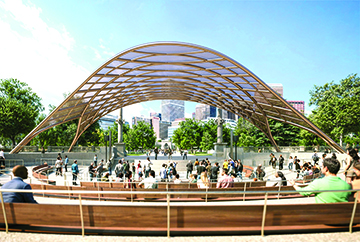
by Valley Gadfly | Mar 28, 2025 | Main Articles
As Civic Center’s Next 100 Plan Gets Set To Start, Hope Is Change Will Enliven City Core, Reduce Crime
by Glen Richardson

Civic Center Today: Civic Center Park was constructed in 1917 as an open stage with murals by local artist Allen Tupper True.
By creating a civic renaissance of sorts, Denver hopes the makeover of Civic Center Park at the intersection of Colfax Ave. and Broadway — one of the Mile High City’s five crime hotspots — will help bring people back and turn around downtown.
The park is currently little more than a threadbare notion of civic grandeur that few people use besides the homeless and skateboarders. With constant growth of the Golden Triangle neighborhood as the 16th Street Mall renovation nears completion, Civic Center Park will connect the two and optimistically serve as a gathering spot for events and festivals.
In early 2024, Denver Parks & Recreation contracted with Studio Gang to lead the Phase 1 design of the Civic Center “Next 100” plan. Proposed changes include improvements to the Greek Theater, Central Promenade, and South Plaza. The Landmark Preservation Committee approved the initial design plans on January 21 of this year.
Boost Daily Use
Civic Center Park is Denver’s first National Historic Landmark, and city leaders say honoring its history is critical to its future. Furthermore, they believe the park needs to accommodate its traditional uses while also encouraging increased daily use.
Modifications and alterations being proposed include to Bannock Street, the Greek Amphitheater, Central Promenade, plus a new “central gathering” feature th
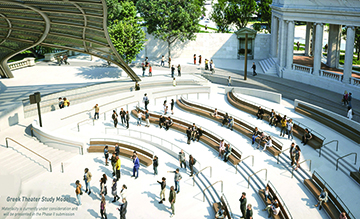
Seating Shift: A rendering of new seating for the Greek Theater in Civic Center Park. The curved stairs in the bowl will be removed, which some experts say is a historical feature. City & County of Denver photo
at has yet to be developed. Parks & Recreation requested and has received comment and suggestions from the public as they get ready to begin the major transformation.
Located at the heart of the city and surrounded by key civic and cultural institutions, Civic Center Park has in the past, and is expected to continue serving as a significant gathering spot for cultural events, festivals, and First Amendment rallies.
Makeover Features
The makeover will feature good-looking greenspaces, improved pedestrian access, and community event sites to attract increased usage. Direction that the theater’s audience faces will change from south to north. In addition to the direction the audience faces, the stage’s openings change from northward to south. A new stage is being added near the park’s center; thus, the amphitheater bowl will function in reverse of how it does currently.
More importantly, a new food truck promenade is being added. Furthermore, landscapers are creating fresh, innovative garden spaces. Finally, a memori

Proposed Remodel: A rendering of the proposed changes to the Greek Theater in Denver’s Civic Center Park designed by globally-renowned architectural firm Studio Gang. City & County of Denver photo
al to disability activists of the Gang of 19 will be installed.
Civic Center Park’s new designs are being created by Studio Gang, a Chicago-based architecture and urban design practice. Studiotrope Design Collective — the Denver-based architect firm that designed Levitt Pavilion and upgrades to the new Central Library — are assisting with the design project. Landscaping is being done by Philadelphia’s OLIN with assistance from Tina Bishop of Denver’s Mundus Bishop.
Small Crowd Design
Significantly, the new park designs are being created to allow for increased individual, daily use versus the huge events of the past. You’ll recall, the park has hosted everything from sports championship parades to the massive Denver PrideFest, and Cinco de Mayo Festival. With the downsize of events, park features are being spread across a broader area of the park.
This time the designers want the space more usable for events that serve 1,000 people or fewer. That will make events more cost-effective for community groups using the space. Moreover, audiovisual infrastru
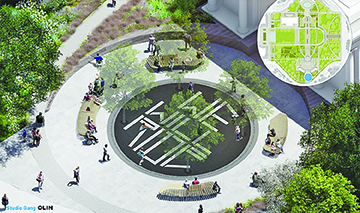
Disability Honor: Rendering of Studio Gang’s memorial commemorating Denver’s Gang of 19 disability advocates for Civic Center Park.
cture is being added within the park.
Although the structure around the amphitheater bowl is a historic landmark, the bowl of the theater was rebuilt in 2004 and is no longer considered historic, so adding seats and altering its orientation is allowed. The new stage will be opposite the current theater stage, with an arch cover over the stage.
Stage Of Steel
The arch over the new stage will be made mostly of steel, but Studio Gang designers are still deciding on the material to use. The goal is to use material between the steel beams that allows some light to pass through the structure.
The updated design also includes new seats. They will be built in a radial pattern that can be opened or closed based on the size of the event. Visitors will also be able to sit inside the historic colonnade walls of the amphitheater. The seating will also be used by those having lunch at events such as Civic Center EATS. In addition to the seats, people can use the stage area for yoga classes and other activities, not just musical performances.
Another park upgrade is that the amphitheater bowl will be wheelchair accessible, with properly sloped pathways around the outer edge of the amphitheater plus the main seating bowl. Those paths will connect all the way to the southern plaza, something that currently is not possible for those who use wheelchairs.
Southern Plaza Facelift
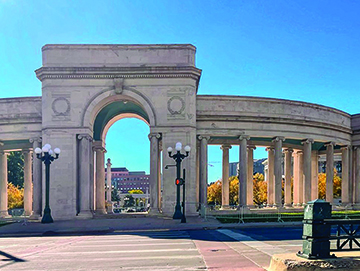
Voorhies Memorial: Memorial in Civic Center Park was home to a temporary art display in honor of 2020 World Day of Remembrance.
A facelift is also being given to the southern plaza near East 14th Ave. A memorial is being created to honor the Gang of 19 — disability activists led by Reverend Wade Blank that ditched their wheelchairs and crawled onto then-inaccessible RTD buses at Colfax and Broadway in 1978.
Those demonstrations caused RTD to become the first mass transit system in the nation to be fully wheelchair-accessible.
The memorial will feature a large central feature bearing the words “we will ride,” as well as seating, trees, and other information about the Gang of 19.
Promenade Plans
Aside from the amphitheater and the space directly around it, the north-south promenade across the park will be revamped, as will several other of the park amenities.
The promenade is currently the only active space in the park. That causes crowding in the one area, while much of Civic Center’s 12-acre urban oasis isn’t used nearly enough. Garden rooms on the east and west sides of the promenade will reorient current planting plots which are now only on the west side of the promenade.
Finally, a new public garden walk will be placed on the southwest side of the park between the Greek Theater and the City & County Building. Both spaces will be planted with year-round or perennial foliage. Current gardens are effective, but not accessible to the public from the promenade.
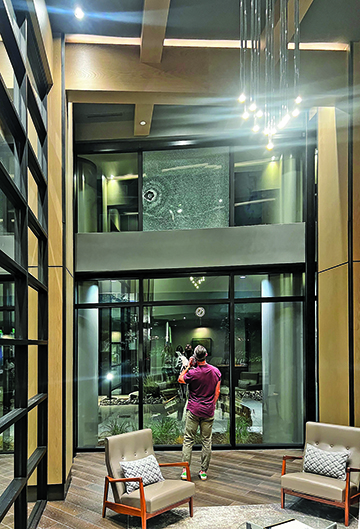
by Jessica Hughes | Mar 28, 2025 | Main Articles
by Jessica Hughes

Inside Gables Vista where bullet holes ripped through the lobby. Resident photo
No matter the price tag for rent, renter’s rights still matter. Gables Vista apartments in Cherry Creek, where rent prices average $2,000 per month, has garnered much criticism from its residents. Built in 2020, it only took the property five years to rack up a myriad of safety and habitability concerns. When a local resident first moved in, she described the building as being very safe, upscale, and, in general, had a positive initial experience. But in the last two years, things have changed and not for the better.
The first incidence of note she remembers took place in November 2023 with a drive-by shooting in front of the property. Since then, she had heard about cars getting broken into at the property over the last year, packages stolen from the front desk, and the concierge’s car stolen in 2024 from the guest parking lot. With crime ramping up at the property, she said she felt like the management team wasn’t being proactive enough in preventing these crimes.
But the most recent drive-by shooting on June 29, 2024, frightened her the most when multiple shots were fired into the lobby and ricocheted into a fourth-floor apartment. According to several residents, the family member of another resident had invited people into the building for a party, who were identified as aggressive and harassing other residents — despite the property’s policy of only two guests per resident at the pool and other public amenities spaces. After eventually being kicked out, the party crew continued out front harassing others and then that’s when roughly 20 shots were fired into the building.
The bullet holes shot into the building were left without repair for months and communication from management about the incident lacked empathy and any real concern for their safety according to residents. Despite safety concerns and expressed needs for additional security, she says management never implemented any additional safety enhancements like 24/7 security, even though management claimed an increase in patrol which she never witnessed.
In addition to safety concerns, the property experienced a slew of maintenance issues, including a carbon monoxide leak with little to no communicat
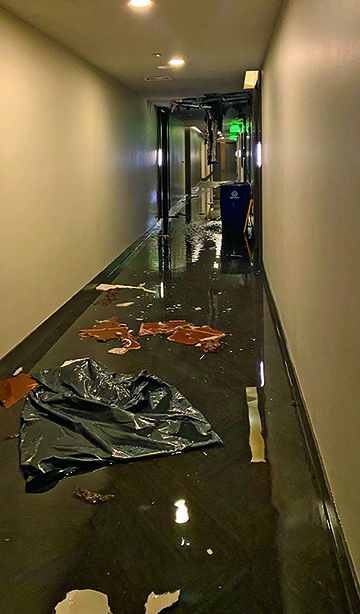
Interior damage at Gables Vista residents were forced to live amongst for days. Photo from Google reviews: Roy Ben Tzvi
ion from management, a gas leak and building-wide gas shut down leaving residents with no access to hot water or gas ranges for several days, and failed pipe repairs that caused two floods in the building’s 4th floor and 3rd floor parking garage, which prompted some residents to call the Colorado Department of Public Health and Environment.
Beyond our interview with this particular resident, a simple search on Google for Gables Vista reveals numerous one-star Google reviews from residents who have plenty to say about living conditions at this property. Some include: “Want bullet holes in your lobby doors for 3 months? Broken elevators and hot tubs that take 1-2 months to fix? Broken fridges take 2.5 months to fix? This was all in the last 6 months — been here for 3+ years and Gables Vista has become unlivable. Don’t recommend to anyone and will be leaving as soon as we can,” said Max Carlson from Google Reviews.
Another review from Evan Haas said, “Such a shame. New staff every week because they’re tired of tenants complaining about all of the things wrong with the building. Management refuses to address anything. Since the summer we’ve had break ins, cars stolen, drive by shootings, multiple water pipe leaks (not even winter), gas leaks, and the only hot tub has been down for a total of 4 months. And if you try to leave, they force you to pay to break your lease.”
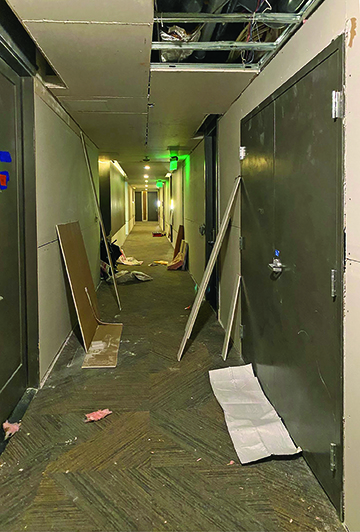
4th floor flood at Gables Vista that left residents in peril for days. Photo from Google reviews: Roy Ben Tzvi
The reviews continue warning others, “DO NOT move in here,” each coupled with photos and videos of tenants walking through inches of water from the flooding on the 4th floor.
The living conditions at Gables Vista got so bad that she reached out to the building inspector with the City and County of Denver, the CDPHE, and the office of councilwoman Amanda Sawyer explaining their concern for safety and habitability issues. Also trying to understand their legal rights as renters, she sought out information from the Colorado Poverty Project. Providing insight into the Warranty of Habitability, a specialist from the CPP cited…
“Under C.R.S. 38-12-503(3), if a tenant finds their residential premises uninhabitable due to a condition, notifies the landlord, and the landlord doesn’t respond within the specified timeframes (14 days for regular issues, 7 days for urgent ones), it’s presumed the landlord breached the lease. Then, it’s up to the landlord to prove otherwise.”
“According to C.R.S. 38-12-503(4) as modified as of May 3, 2024, if a condition seriously affects the tenant’s life, health, or safety, the landlord must offer alternative housing at the request of the tenant and at no cost to the tenant within 24 hours from that request. This housing should be like the tenant’s current place (including the same number of beds as the uninhabitable unit) and within 5 miles of the uninhabitable unit. The landlord is responsible for paying reasonable costs and a per diem for expenses that the tenant needs to pay to relocate to the alternative housing. If the alternative housing is needed for more than 48 hours, the landlord must either provide a kitchen setup or offer a daily allowance for m
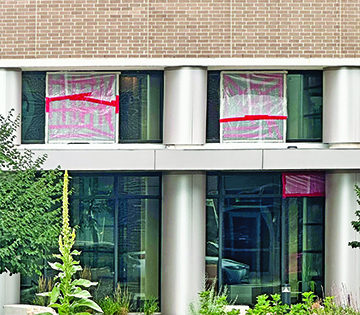
Building windows at Gables Vista sat unfixed for months after the shooting in June 2024. Photo from Google reviews: Max Carlson
eals and expenses.”
Residents say they received an email from management offering to reimburse for a day at Colorado Athletic Club to shower when water had been shut off for 12 hours due to a pipe repair, with no indication of when the water would be turned back on. And when an entire floor flooded, residents were sent emails stating they would not be put up into hotel rooms or reimbursed for food or other needs. Despite Colorado law, it appears on a few occasions that Gables Vista failed its tenants.
Amidst all of these issues, residents also learned the lease had been recently revised to not include a lease-break option, a $100 lease change fee was added as well as an extra charge for maintenance, and a $100 admin fee to renew your lease. One resident even reported her checking account information was removed from the pay platform leaving her with only debit or credit options, which charge a fee.
All of this has left current residents wondering “What’s next?”
Gables Vista sits at 375 S. Jackson St. in Cherry Creek. The 12-story property holds around 250 units and is owned and operated under Gables Residential. When asked how Gables Vista management was handling these issues, they declined to comment.
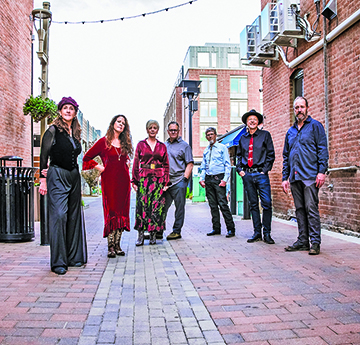
by Mark Smiley | Mar 28, 2025 | Main Articles
Tickets For The Wednesday Evening Concert Series Are On Sale Now
by Mark Smiley

July 16: A Tribute to Joni Mitchell, featuring vocals by Front Range mainstays, Liz Barnez, Rebecca Folsom, and Celeste Krenz. This concert sold out Swallow Hill’s 300 seat room in the fall, and the band is excited to bring it outdoors this summer.
Music and memories go hand in hand. Hearing a beloved song from our youth can transport us back in a way few other things can, while creating new memories in the process.
Swallow Hill Music is proud to announce the return of tribute concerts at Four Mile Historic Park on Wednesday evenings this June and July. The concerts will start on June 4 and run every Wednesday until July 16. The Denver-based music nonprofit introduced its lineup of tribute shows last summer and music lovers responded in record-breaking numbers, creating a multigenerational experience — and memories — in the process.
Picking up on last summer’s momentum, this year’s lineup welcomes U2 tribute band Bullet The Blue Sky, Fleetwood Mac tribute Rumours, Santana tribute Santa Rios, and Rolling Harvest, a Bob Dylan-Neil Young tribute.
Returning to the concert series are Denver’s venerable Grateful Dead tribute band Shakedown Street, and Sugar Britches with their John Prine tribute show.
Rounding out the lineup is A Tribute to Joni Mitchell, featuring vocals by Front Range mainstays, Liz Barnez, Rebecca Folsom, and Celeste Krenz. This concert easily sold out Swallow Hill’s 300 seat room in the fall, and the band is excited to bring it outdoors this summer.
Pack a picnic dinner and spread out on the lawn at Four Mile Historic Park to take in a night of unforgettable music in a family-friendly setting. Outside food & non-alcoholic drinks and coolers are allowed, but outside alcohol is not permitted. An onsite bar will be available.
The Wednesday night concerts begin at 6:30 p.m., with Four Mile Historic Park opening at 5:30 p.m.
See the full lineup and get complete details on the website mentioned below. As a nonprofit, ticket purchases to all Swallow Hill productions help support bringing more music to the Denver metro community through concerts, as well as our music classes and music in preschool programs. Thank you for supporting summer concerts with Swallow Hill Music.
Visit swallowhillmusic.org//four-mile for a complete schedule and for tickets. Tickets are $20 and $15 for Swallow Hill and Four Mile Members. Kids ages 4-12 are $10, children 3 and under are free. Four Mile Historic Park is located at 715 S. Forest Street in Denver.

by Charles Bonniwell | Feb 19, 2025 | Main Articles
155 Acres Will Be A Permanent Park
Wellington Webb Hailed As A Hero
by Charles C. Bonniwell
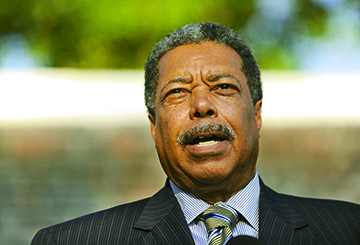
Victor: Former Mayor Wellington Webb helped lead the years-long struggle to keep the old Park Hill Golf Course as Open Space and not a dense mixed-use development.

Coming Soon: The old Park Hill Golf Course will be converted into a regional park to open this summer.
A decades long battle on whether the 155 acres which comprised the old Park Hill Golf Course would be a permanent park and open space or paved over for a dense mixed-use development has finally reached a conclusion. The Park Hill residents overwhelmingly appeared wanting an open space park but aligned against them was a developer (Westside Investment Partners) who stood to make tens of millions of dollars from development with the strong backing and power of the mayor, City Council, and all of the agencies of city government. It appeared inevitable that the development would occur notwithstanding what the residents earnestly wanted. Citizens almost never win this type of battle yet this time it was different.
Opposing the developer/government juggernaut was an underfunded rag tag residents group by the name of Save Open Space Denver (SOS) in conjunction with former Denver mayor (1991 to 2003) and Park Hill resident Wellington Webb. Notwithstanding the David versus Goliath nature of the battle, on January 15 the present Denver Mayor Mike Johnston announced that the city had engaged in a land swap whereby Westside Investments would be given 144 acres of empty industrial zoned property near the Denver International Airport for the 155 acres of the old Park Hill Golf Course. The swap ensures that the Park Hill acreage would be a city park, the fourth largest in the City and County of Denver and the largest acquisition of park land in the city’s history. It makes certain that the entire greater Park Hill neighborhood will continue to be one of the gems of Denver. The tale of this miraculous victory by the residents over their own government and a powerful developer is one of the most heartwarming tales of 21st century Denver.
Park Hill
What is today the Greater Park Hill neighborhood began in 1887 when the German Baron von Winkler sought to subdivide 32 acres of land east of Colorado Boulevard for an upscale re

Clayton College Campus: The Clayton College campus was designed by Maurice Briscoe and Henry Hewitt in the Italian Renaissance Revival-style with sandstone masonry.
sidential neighborhood. The Silver Crash of 1893 greatly hindered his plans. In 1898 he committed suicide with the poison strychnine and a gun, but his dream of development would slowly be fulfilled.
Today, Park Hill, sometimes referred to as Greater Park Hill, has approximately 30,000 residents divided into three distinct neighborhoods running up Colorado Boulevard. It starts with South Park Hill running from 17th Avenue and ending at 23rd Avenue. It is predominately white, affluent,
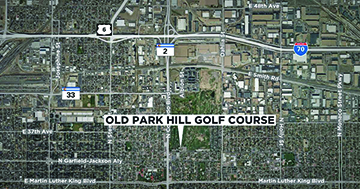
Location: The new park will be at the southwest corner of the Northeast Park Hill neighborhood along Colorado Boulevard.
and contains some of the most beautiful homes in all of Denver. Next is North Park Hill which runs from 23rd Avenue up to Martin Luther King Jr. Boulevard (formerly 32nd Avenue). It is generally affluent but less than South Park Hill and is more evenly split between black and white residents. Further north is Northeast Park Hill which runs from Martin Luther King Jr. Boulevard to 53rd Avenue. It is largest of the three neighborhoods in size, but smallest in population and the least affluent. At one time Northeast Park Hill had an overwhelming black population. In recent years Hispanic and white residents have been increasingly moving in.
The Estate
The Park Hill Golf Course property is on the southwest corner of Northeast Park Hill starting on Colorado Boulevard and just north of Martin Luther King Jr. Boulevard. The story of the golf course goes back to 1889 when a successful businessman, George Washington Clayton, was found dead slumped over his desk. With his wife and child having predeceased him, he left his fortune and property to the city of Denver for the purpose of an orphanage for white boys born in Colorado from respectable families. Racism, class division, and corruption would be a constant theme regarding his estate and Park Hill. The estate was valued at $2 million dollars in 1889 which is equivalent to $75 million today and his estate included numerou

Jackpot Winner: Charlotte Brantley as CEO of the Early Learning Center came out as the big monetary winner regarding the old Park Hill Golf Course. She sold on behalf of the Early Learning Center/Clayton Trust a conservation easement on the Park Hill Golf Course but then turned around and sold the land to Westside for $24 million as if no conservation easement existed.
s real estate properties.
Federal judge Moses Hallett was made the executor of the estate and charged with creating the orphanage. In 1903 he was accused of mismanaging estate funds, including using assets for his own purposes, and illegally
paying himself from estate funds. Nonetheless, under his tutelage the construction of the orphanage was completed by 1910 to be called Clayton College for Boys and turned it over to the city in 1911.
The Golf Course
The estate became the George W. Clayton Trust with the City and County of Denver as the sole Trustee. The orphanage was housed i

Ceremony: Mayor Mike Johnston brings up to the podium the victorious former Mayor Wellington Webb at a January 15, 2025, press conference announcing the land swap and creating a regional park at the old Park Hill Golf Course.
n beautifully constructed buildings and called Clayton College for Boys. Across Colorado Boulevard from the buildings at Martin Luther King Jr. Boulevard was a 155-acre dairy used to help teach the orphans agricultural skills. The dairy farm operation ceased and in 1932 the land became the Park Hill Golf Course under a lease agreement with an operator.
The City and County of Denver as the sole Trustee proved to be no less corrupt than federal judge Moses Hallet. The city managers of the estate were found to be selling trust properties to friends and business associates at far below fair market prices and other acts of self-dealing. In 1982 the city was replaced by a foundation called the Clayton Foundation with no assets and a volunteer board to be the sole trustee of the Clayton Trust.
The orphanage was closed in 1957 due to the lack of boys fitting the restrictive provisions. In 1969 the Colorado Supreme Court court amended the provisions of the trust to eliminate the restrictions with regard to race, gender, and family background. In 1991 the Clayton Foundation became the Early Learning Center for the purpose of assisting low-income families with children from birth to three years old. In 1995 it became associated with the federal Head Start program. Critics have declared the program to be little more than a federally supported day care center whose main beneficiaries were the overwhelmingly white female teachers and administrators who paid themselves handsome salaries along with generous perks and pensions. It was ruefully noted that the Early Learning Center was as racially segregated as Clayton College for Boys with the white female teachers serving almost exclusively black and Hispanic families with no white male boys in the mix.
Like the managers and trustees before them, the white female teachers and administrators led by CEO and president Charlotte Brantley, were accused of attempting to convert the assets of the trust (the Park Hill Golf Course land) for their own benefit.
Marketing The Property
The 155 acres is located on the southwest corner of Northeast Park Hill. In the 1950s and 1960s real estate agents and bankers started a real estate stampede known as “white flight” by going door-to-door telling white residents that they needed to sell as soon as possible because blacks from Five Points were increasingly moving in causing property values to plummet.
Eventually many of Denver’s black political leaders came from Park Hill including Denver’s first black mayor Wellington Webb. In 1997, in order to prevent the land from being sold to developers to meet the money desired by the Early Learning Center, Webb arranged a deal whereby the city paid two million dollars to the Early Learning Center in return for a conservation easement on the land, whereby it was to remain a golf course or open space.
The Early Learning Center quickly blew through the 2 million dollars and soon hunted for more funding. In 2011 Micheal Hancock became the second black mayor of Denver, but unlike Webb had no interest in parks and open space and was almost universally deemed to be in the back pocket of developers. Neither the Hancock Administration nor Early Learning Center seemed to care that the property had a conservation easement for open space on it which the citizens wanted to keep. The Early Learning Center’s Brantley started talking about envisioning the 155 acres, but no mention of returning to the taxpayers the money it had taken.
In 2017, a convoluted agreement was drawn up with the city buying the land for $20 million and indicating the Early Learning Center would jointly develop the property. The agreement was so convoluted that the City Council balked.
Wellington Webb wrote: “In 2017 the Denver city administration and the landowner, Clayton Trust [managed by the Early Learning Center] , thought they would be able to terminate the conservation easement between themselves simply with a wink and a nod and city council approval. Had it not been for Arcis Golf, the company that operated the golf course crying foul, termination of that agreement would have flown under the radar, tucked into a measure for a vote by Denver City Council to approve the sale and development of that 155-acre, tree-filled green space.”
Before that litigation was resolved the state legislature enacted a new law in which an impartial judge would have to rule that conditions had to have changed so that the purposes for easement no longer existed. The legislation appeared to save the land as open space but no. A Denver judge would later rule quixotically that the citizens had no standing to enforce the easement.
The Rise Of Opposition
But the initial contract to sell and subsequent lawsuit alerted Park Hill residents that Park Hill Golf Course land would be paved over for development unless they organized and fought back. SOS was formed with the help of two lawyers, Penfield Tate III and Woodsey Garnsey, soon to be joined by Webb.
In 2018 the golf course was closed and in 2019 Clayton Early Learning announced that it had agreed to sell the land to Westside Investment for $24 million, which shocked observers since the property was worth about $3 million with the conservation easement. It was assumed the fix was in with the Hancock Administration agreeing to lift the easement and approve any redevelopment.
Westside and the City then went on a full-bore public relations campaign to get the public behind the redevelopment. The city hired a firm to poll what the citizens wanted for the area which unsurprisingly came out with affordable housing. SOS was able to show that reality using a push poll, whereby the questions led the person being polled to the conclusion that the poller wanted. The city also set up the Park Hill Golf Course Area Visioning Process whereby city staff would meet up with various neighborhood groups to work through what they wanted to do with the land. The city staff, of course, were not honest brokers, which was demonstrated when they threw SOS out of the process saying that only those who wanted redevelopment could participate and not groups hoping to keep the property as an open space park.
SOS however continued to be proactive. It put on the November ballot Ordinance 301 which would require a citywide vote approving the lifting of a conservation easement. Westside then also got Ordinance 302 on the ballot which required such a vote in all cases except Park Hill Golf Course. SOS crushed Westside at the polls with Ordinance 301 winning with over 60% of the vote and Ordinance 302 losing by the same margin.
Westside through generous campaign contributions directly and indirectly had control over a large majority of the 13-member City Council. Westside got its small area plan approved by an 11-2 margin. The City Council also hoped that a scheduled April 4 vote on lifting the conservation easement would be favorably influenced by the approved redevelopment plan.
With tens of millions at stake Westside threw in everything it could including the race card. Westside and the City proclaimed if the land was a park it would make the area far more attractive and “gentrify” the area. Gentrification was a code whereby affluent whites would buy up properties

Driving Force: Andy Klein, the founder and CEO of Westside Investment Partners employed every trick and artifice to turn Park Hill Golf Course into a mixed-use development but ultimately failed to overcome the Park Hill Residents desire for a park.
displacing blacks. It is the flipside of “white flight.” The Westside redevelopment plan provided significant affordable housing which would attract black buyers and keep the area with a majority of black residents.
Given the enormous resources Westside would pour into the racist flavored campaign, and how little SOS and the other neighborhood groups had to spend, it was assumed Westside would win. To the shock of many Westside lost badly with over 60% voting to keep the conservation easement.
The Stunning Swap
Wellington Webb and the neighborhood groups had stopped the redevelopment of Park Hill Golf Course by their incredible election victory but were not any closer to making it a park. Westside still owned the land subject to a conservation easement which allowed golf course operations as well as open space. In a pique of anger Westside fenced off the property and did minimal maintenance.
Westside also threatened to turn a part of the property into a multi-story Top Golf driving range serving alcohol with loud music. Mayor Hancock had declared that the city would never buy land for a park, as it was way too expensive for the city budget.
For open space advocates the long nightmare of Mayor Hancock was to be over in 2023, with the mayor term-limited out of office after 12 long years. But the leading candidates appeared no less unfriendly to parks and open space. While the two runoff candidates, Mike Johnston and Kelly Brough, agreed on very little but they did agree that the property should be redeveloped by Westside and not become a park.
It was therefore one last surprising turn of events concerning the Park Hill Golf Course when Johnston announced on January 15 of this year that Denver was acquiring the land for 144 acres of industrial zoned land close to the Denver International Airport to swap for the old Park Hill Golf Course. The 155 acres will become a regional park improved and maintained by Denver Parks and Recreation.
At the press conference the mayor recognized Penfield Tate and Woody Garnsey of SOS and brought up Wellington Webb to a hero’s welcome.
The residents had, against all odds, “beaten city hall.” Future generations of Park Hill residents will be the beneficiaries of the unbelievable fight and victory of Wellington Webb, SOS, and an intrepid band of fighter residents from the Park Hill neighborhood.
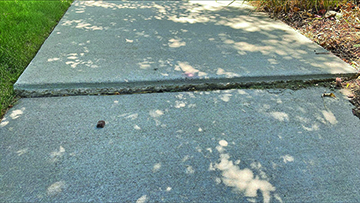
by Valley Gadfly | Feb 19, 2025 | Main Articles
You Don’t Own Sidewalks At Homes, Businesses, But City Set To Charge You $150 Per Year For Repairs
by Glen Richardson
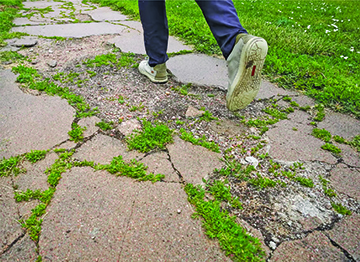
Stumbling Steps: Denver residents have stumbled along with broken sidewalks for years. Now the city will begin to fix them.
The Mile High City has found a fast path to get back on its feet. After stumbling along with broken sidewalks for years, this year the city is starting to charge homes and businesses $150 per year to fix sidewalks, “Unfortunately,” Denver admits, “there are many sidewalks in need of repair and about 40% of our sidewalk network is either missing or too narrow.”
The fee applies to all property types, both housing and stores. Moreover, the city says property owners who don’t have a sidewalk along their property will still have to pay the fee.
Additional charges — yet to be determined — will be added to properties with significantly more sidewalk frontage than the average property owner. The latest changes also mean property owners who live on private streets will be charged fees, even though they will continue to be responsible for their own upkeep.
All Properties Fee
Voter approved in November 2022, the city will use the fee to repair hazardous sidewalks, reconstruct sidewalks that are deficient, and build sidewalks where they’re missing.
“Since everyone benefits from a complete sidewalk network,” city officials declared in a controversial decision that all Denver
property owners will have to pay the fee.
The $150 per year fee — that the city says could increase due to inflation — will be split into two payments, with each half appe

Sidewalk Supervisor: Newly appointed Department of Transportation & Infrastructure (DOTI) appointee Amy Ford will direct sidewalk work.
aring on the property owner’s bi-annual stormwater bill. The average annual cost for sidewalk maintenance per capita in other major U.S. cities is between $30 and $60.
$40 Million Per Year
“Ordinance 307 will begin to fix or build functional sidewalks for the 40% of the city’s streets that are missing them,” according to Denver’s Department of Transportation & Infrastructure or DOTI.
DOTI — headed by Amy Ford, a Dallas consulting firm appointment of Mayor Mike Johnston — estimates the fee will bring in $40 million a year for sidewalks. The ordinance says the work should be done in nine years, but the city can take longer if that’s not possible. Back in 2022, the city estimated it could take nearly 30 years.
Most other cities charge for sidewalks by requiring property owners to pay a fee based on the linear footage of sidewalk directly in front of their property, meaning they are essentially charg

Paving The Way: The City of Denver is set to begin charging homes and businesses $150 per year to fix sidewalks.
ed per foot of sidewalk they are responsible for maintaining.
Large Lots Extra
Properties that have more than 230 feet of street bordering their property, such as those with corner-lots, will be charged an additional $3.50 per foot over 230 feet. At locations where sidewalks don’t currently exist, property owners will pay either the flat fee or flat fee with impact fee, based on the length of the public right of way where a future sidewalk will be constructed.
While the program’s original language called for the city to get the job done in nine years, part of the changes approved recognized that might not be possible, expanding the timeline to “soon thereafter.”
A city analysis in 1922 estimated Denver sidewalks would cost $2.8 to $7.3 billion, far more than the $40 million the city says it

Filling The Gap: Fixing or eliminating gaps in sidewalks improves the safety and comfort for pedestrians, cyclists, and other users.
will cost in 2025.
Rebates Obtainable
The sidewalk program also provides a way for property owners to apply for a rebate on their sidewalk fee based on income and household size.
Property owners already receiving the city’s instant rebate for solid waste management services will automatically receive the sidewalk rebate and will not need to re-apply.
More: Now homeowners only have to fill out one application to determine their eligibility for DOTI’s Solid Waste Service Rebate and Sidewalk Program Rebate. Trash rebate participants who receive a stormwater bill will automatically receive the sidewalk rebate.
Two Payments Yearly
The fee will appear on municipal stormwater bills. It will be divided into two payments for the first and second half of the year.
Whether a homeowner’s block has

Closed For Overhaul: With about 40% of Denver’s sidewalks either missing or too narrow, residents will see a lot of this sign. Photo by Hart Van Danburg
proper sidewalks or not, property owners have to pay. Even if they don’t have a sidewalk along their property, they still have to pay. If they have a homeowner’s association that handles their stormwater bills, the HOA would handle the fee.
The program will build sidewalks to the current city standard. If a district has existing decorative or beyond-standard sidewalks, the city will repair or repave the sidewalk to city standard, but not to the district’s beyond-standard sidewalk. Any changes to the district’s assessment to reflect a decreased need for sidewalk funding as a portion of their assessment would need to be handled according to the district’s budgetary rules.
Citizen Damage Reports
While DOTI says it stands up for the city’s new sidewalk program, people will be able to report major sidewalk damage on Denver’s Online Services Hub. DOTI will inspect and triage reports received and those that meet certain criteria will be placed on a spot repair program. Examples of sidewalk issues that may be addressed in the spot repair program include: a) Adjoining sections of sidewalk with an elevation difference greater than one inch; b) Adjoining sections of sidewalk with gaps greater than one inch; and c) Extensive raveling and major breaking.
Large properties — including Denver’s Department of Parks & Recreation and other government entities with big tracts of land — could face significantly higher bills if they have more than 230 linear feet of sidewalk running along their lots.
Once money starts flowing in from fees, DOTI will hire a concrete contractor to start making repairs. It will also hire a consultant to create a sidewalk master plan. All of that is mandated in the original law voters approved. Once fully built out, Denver’s sidewalk network will be approximately 3,489 miles, or about the distance from Denver to New York City and back again!

by Valley Gadfly | Feb 19, 2025 | Main Articles
Parade, Good Luck Charms, And All Things Green To Add A Bit O’ Fun For St. Paddy’s Day On March 15
by Glen Richardson
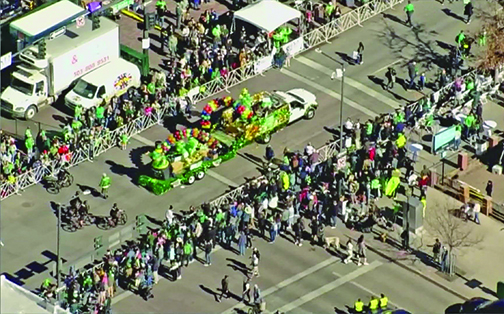
Irish Trek: Bagpipers, bands, leprechauns, floats, and half a million people are expected for the St. Patrick’s Day Parade March 15 starting at Wynkoop St. and 19th Ave.
Bagpipers, bands, leprechauns, and floats, the Mile High City becomes Dublin for a day as the city celebrates St. Patrick’s Day with a wee bit early parade on Saturday, March 15. The actual holiday is Monday, March 17.
With green and glee, the parade has been running for more than 60 years. Nearly half a million people are expected to attend this year. The city paints a green strip down the parade path on Blake Street. Signage on the street is annually changed to Tooley Street in honor of Dale Tooley, Denver’s district attorney in the 1970s and 1980s.
The parade begins at the corner of 19th and Wynkoop, turns left on 17th Street to Blake St. then marches east on Blake and ends at 27th and Blake at the Coors Field parking lot. The St. Patrick’s Day Parade will fill the streets of Denver on March 15th rain or shine.
Grand Marshal

Luck O’ The Irish: Wishing you all the luck o’ the Irish this St. Patrick’s Day. A good friend is like a four-leaf clover, hard to find, and lucky to have.
The 2025 Grand Marshal is Lisa Switzer! Lisa has been a Denver community member since xxxx and has had a storied career in the nonprofit world. From business development and operations to C-Level strategic planning, her roles have one common thread – they are all mission-based supporting people and communities.
Presenting Sponsor
The parade is organized by volunteers formed and incorporated in 1986 as the Denver St Patrick’s Day Parade Committee. The committee is a charitable organization whose members have a deep love for the Irish culture and enjoy sharing that sense of pride with Valley residents.
While people often assume the parade is presented by the City of Denver, this is the 19th year that Bellco Credit Union has been the parade’s presenting sponsor. Created in 1936, Bellco Credit Union has more than 368,000 members and over $8 billion in assets.
“The Denver St. Patrick’s Day Parade represents a strong sense of community for us, and we’re proud to be a part of it.” says Senior Vice President & Chief Retail Officer John Rivera.
Viewing, Weather

Protein Pie: Originating from Ireland and England, Shepherd’s Pie with minced lamb or mutton is on the menu of most Irish Pubs. Pies with beef are called cottage pies.
To catch the parade’s full performances — including dancing, music sets, etc. — the best spot is generally considered to be south of 20th Ave. on Blake St., which is also the most crowded with attendees arriving as early as 6 a.m. to stake out a spot.
If you hope to avoid larger crowds, a great place for prime viewing is at the end of the parade on Blake St. from 23rd to 27th Avenues.
Remember this is March — the 5th coldest month of the year in Denver — and weather is unpredictable. Temperatures begin the month with a normal low of 22 degrees and high of 50 degrees. The month ends with 30-degree low temps and highs at about 58 degrees.
Runnin’ O’ The Green
To stay in shape to run through the weekend’s Irish activities, participate in this year’s Runnin’ O’ The Green March 9 at Wash Park. Registration is at 8:30 a.m.
The 7K “Lucky 7” kicks off at 10 a.m. followed by the 2-mile “Leprechaun Leap” run-walk at 10:05 a.m.
Don’t run away, there’s a day filled with Irish fun, live music, and awards. A post-race Festival-Expo features Irish music & dancers. The event also includes a Beer Garden.
Classic Celtic Music
Music during St. Patrick’s Day this year in Denver features Celtic groups, acoustic bands, and Irish music bands. This year’s St. Paddy’s Parade (2025) is featuring several bands, including the Michael Collins Pipes & Drums, Nerea the Fiddler, Altan, and The Young Dubliners.

Young Dubs: Irish-American rock band The Young Dubliners entertain at Swallow Hill’s Daniels Hall March 8, 8 p.m.
Irish-American rock band The Young Dubliners entertain at Swallow Hill’s Daniels Hall March 8, 8 p.m. They’re followed March 9 by the traditional Irish band Altan playing at Lone Tree Arts Center, 7 p.m. Another must-see is jigs and reels band Gobs O’ Phun playing at Swallow Hill’s Tuft Theater on March 15, 8 p.m.
An additional St. Paddy’s Day highlight not to be missed is Celtic Awakening playing at the Newman Center March 15-16, 2:30 p.m. Irish tenor soloist Todd Teske entertains. Or, on a St. Paddy’s weekend evening, dress in green, white, and orange and dance a jig at Fortissimo Dueling Pianos on 14th St.
Irish Pub Grub
Yearning for a taste of Ireland to celebrate St. Patrick’s Day this year?
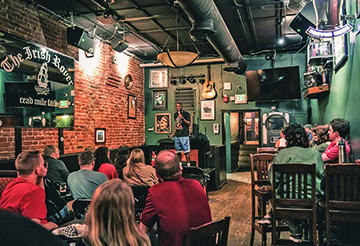
Send Family Over: The Irish Rover along South Broadway in the Historic Baker district is among the top traditional Irish Pubs remaining in Denver.
Denver’s Irish pubs — the traditional haunts for Irish cuisine and beer — continue to decline in numbers or maybe simply morphing into a different era. There are just a wee bit more than a dozen remaining in the Mile High City and several have closed their kitchens. Two of the largest — Fado across from Coors Field, and Maggie Smith’s in Centennial closed. Clancy’s Irish Pub — the Valley’s oldest and longest running Pub — relocated to Wheat Ridge.
Restaurants that offered holiday choices such as corned beef & cabbage on St. Paddy’s Day are also mostly gone. Cherry Creek North’s Cherry Cricket, nonetheless, still offers Corned Beef & Cabbage with Guinness or green beer. Glendale doesn’t have an Irish Pub. Bull & Bush is an English Pub, but it does serve pub classics like fish and chips.
For family dining, the Abby Tavern on East Colfax is easily the best choice. Owner Glen Eastwood spent more than 10 years managing Pubs (Fado & Chasey’s Bistro & Pub). Irish choices include fish & chips, Shepherd’s Pie, an Irish breakfast, plus a Reuben sandwich. Moreover, there are also plenty of American options including burgers.
Among the more traditional Irish Pubs, the two along South Broadway in the historic Baker district are good choices. The Irish Rover has tacos, burgers, and pizza for the kids in addition to fish & chips and shepherd’s pie. Just off Broadway on E. Ellsworth Ave., Dougherty’s Pub — with one of the best pub kitchens in town — boasts authentic Irish cuisine such as Belfast Chicken, Bangers & Mash, and Denver’s best Shepherd’s Pie. They also annually host one of the best St Patrick’s Day street-parties in Denver.




























